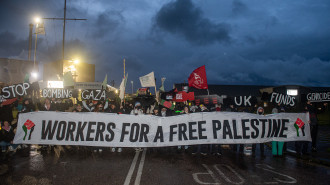UN probe finds no clashes occurred prior to Israeli tank attack that killed a Lebanese journalist
A UN investigation found there was "no exchange of fire" before an Israeli tank shelled journalists in Lebanon in October, killing one and wounding six, its report seen by AFP on Thursday showed.
The investigation by the UN Interim Force in Lebanon (UNIFIL) concluded that the shelling of "clearly identifiable journalists" violated both international law and the UN Security Council resolution which ended the devastating 2006 war in Lebanon between Israel and Iran-backed militant group Hezbollah.
Two Israeli shells hit the group in quick succession as they were working near the border village of Alma al-Shaab on 13 October, killing Reuters journalist Issam Abdallah, 37, and wounding two other Reuters journalists, two from broadcaster Al Jazeera and two from AFP.
AFP photographer Christina Assi, 28, was seriously wounded and later had a leg amputated.
The report on the UNIFIL investigation, which has been handed to both Israeli and Lebanese authorities, concluded that the Israeli army "fired two 120 mm Merkava (tank) shells in quick succession".
UNIFIL's investigation found that as there was no exchange of fire at the time of the incident, "the reason for the strikes on the journalists is not known".
Asked about UNIFIL's findings, the Israeli army said that its forces were responding to missile and rocket fire from Hezbollah and "used artillery fire and tank fire in order to remove the threat and prevent any further attack."
It said a military body would continue to investigate the incident, adding that it "deplores any injury to uninvolved parties, and does not deliberately shoot at civilians, including journalists."
An AFP probe into the deadly attack, jointly conducted with Airwars, an NGO that investigates attacks on civilians in conflict situations, pointed to a 120-mm tank shell only used by the Israeli army.
A Reuters probe, including initial findings from the Netherlands Organisation for Applied Scientific Research (TNO), found that two Israeli shells were fired from the same position across the border.
In its final report released last week, TNO said analysis of audio picked up by an Al Jazeera video camera at the scene showed the reporters also "likely" came under fire from a machine gun mounted on the tank.
Human Rights Watch has said the strikes were "apparently deliberate attacks on civilians, which is a war crime".
Israeli troops and Hezbollah fighters positioned along the border have traded near-daily fire since Hamas fighters carried out an unprecedented attack on Israel on October 7, triggering the devastating war in Gaza.
Since the exchanges began, at least 322 people have been killed in Lebanon, mainly Hezbollah fighters but also including 56 civilians, according to an AFP tally.
In Israel, at least 10 soldiers and seven civilians have been killed, the military says.





 Follow the Middle East's top stories in English at The New Arab on Google News
Follow the Middle East's top stories in English at The New Arab on Google News


